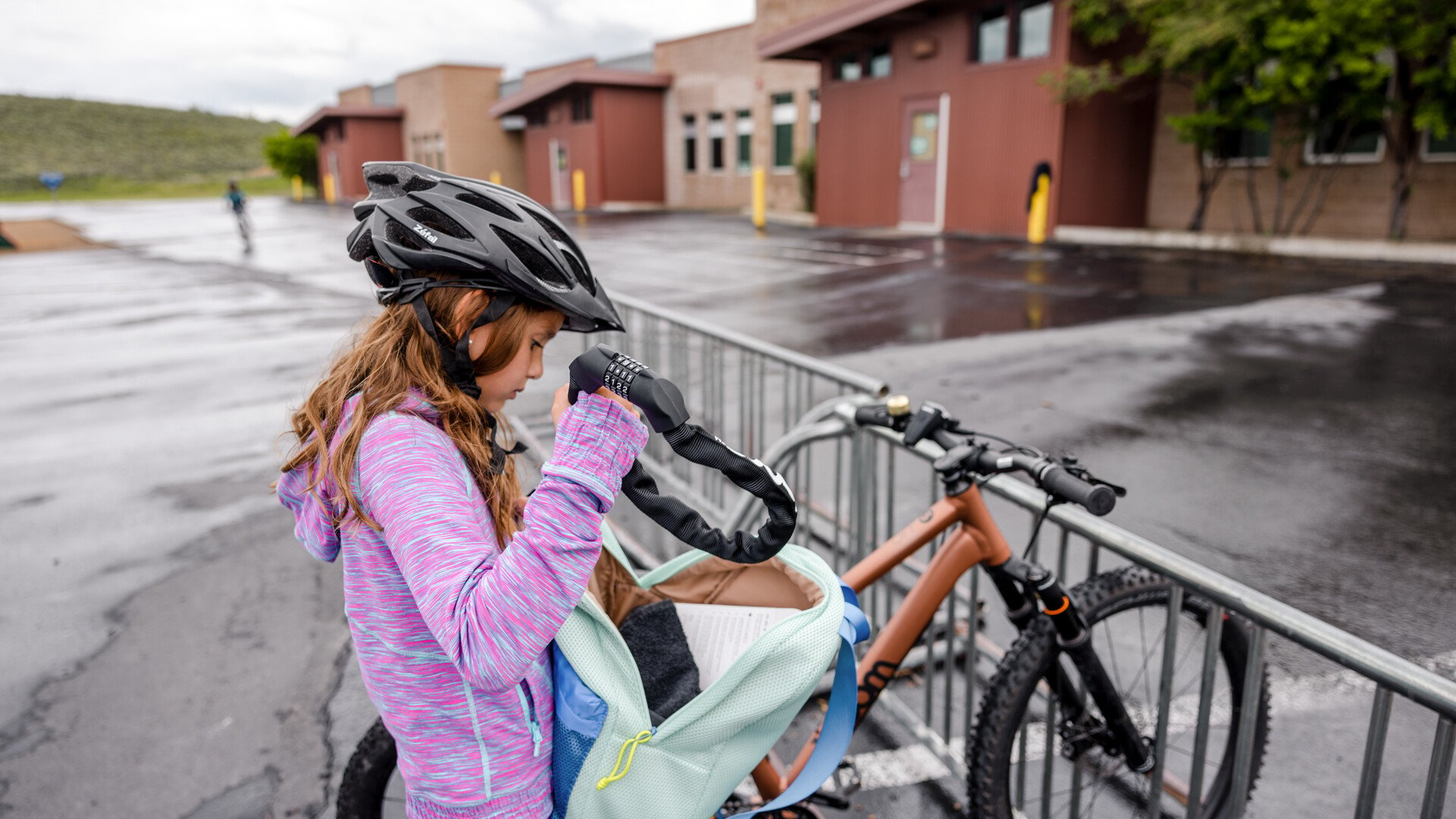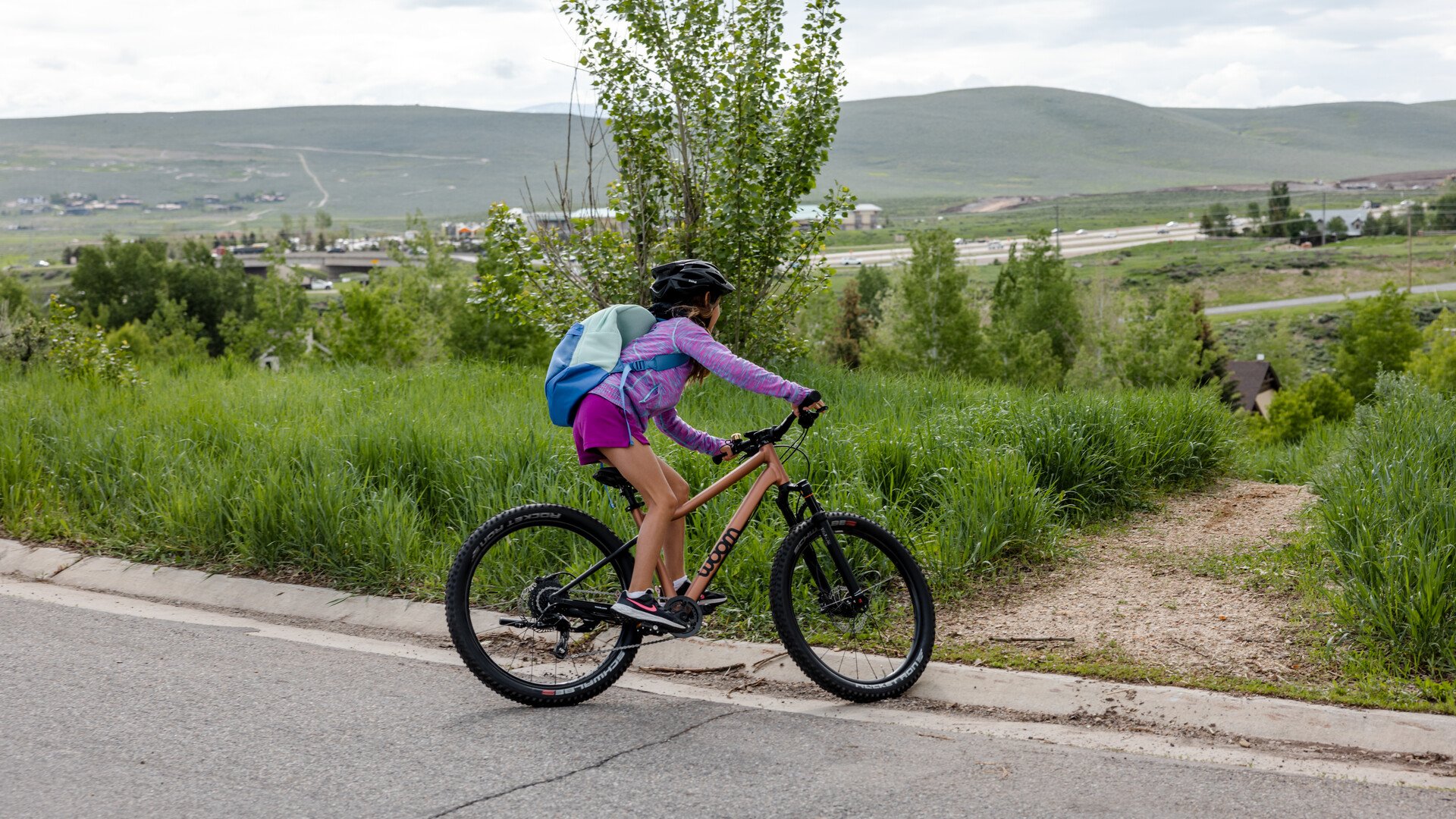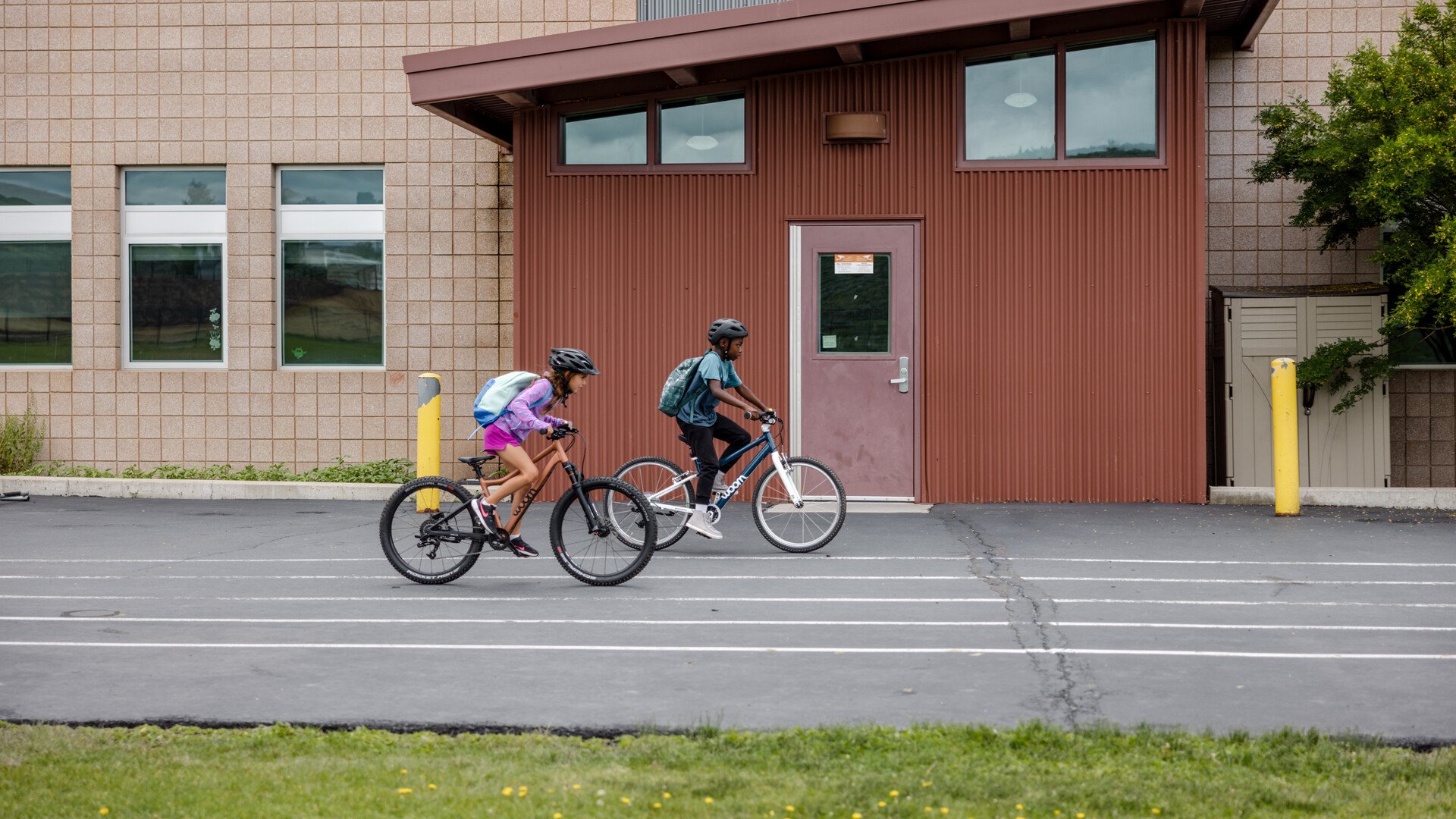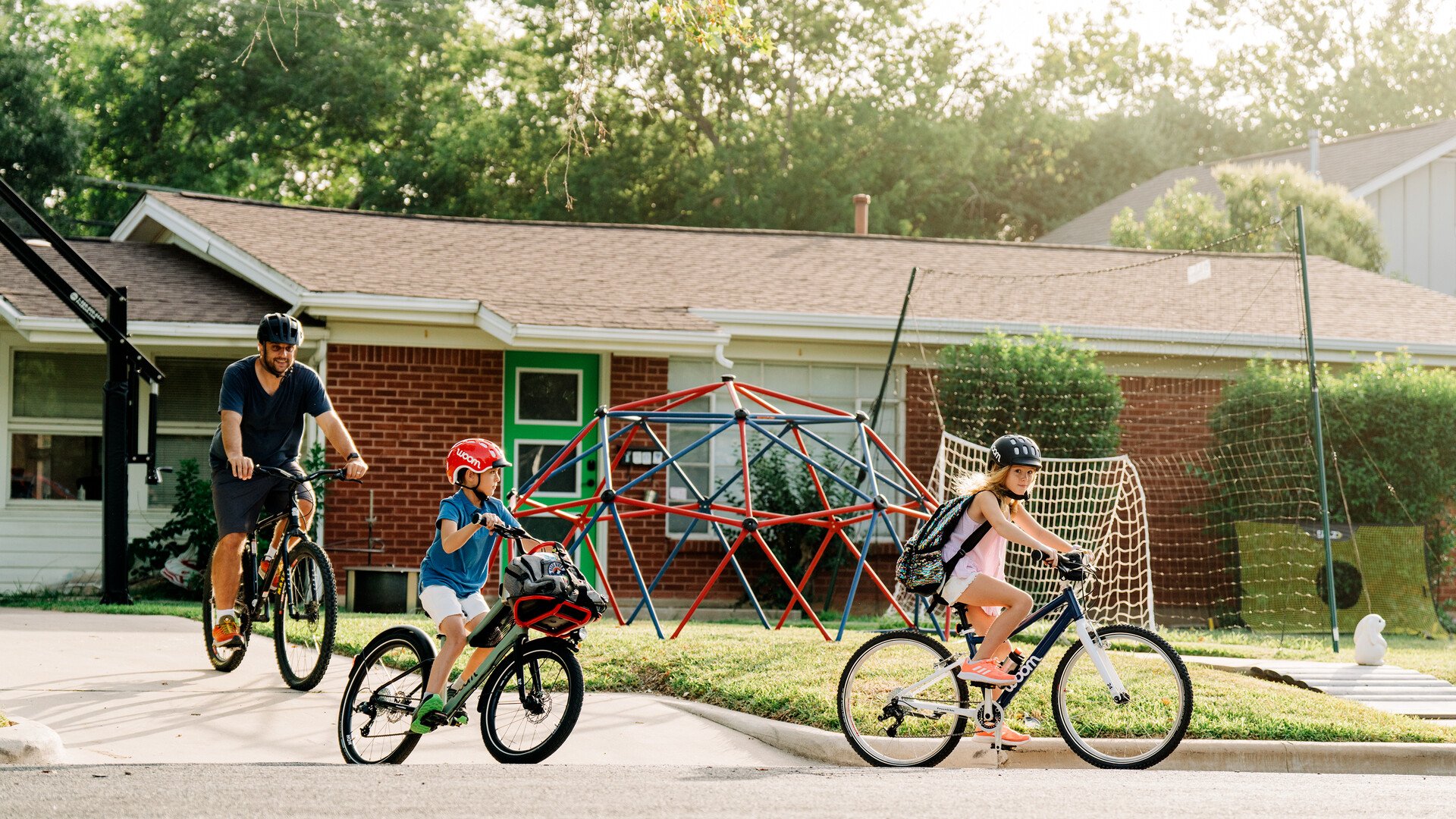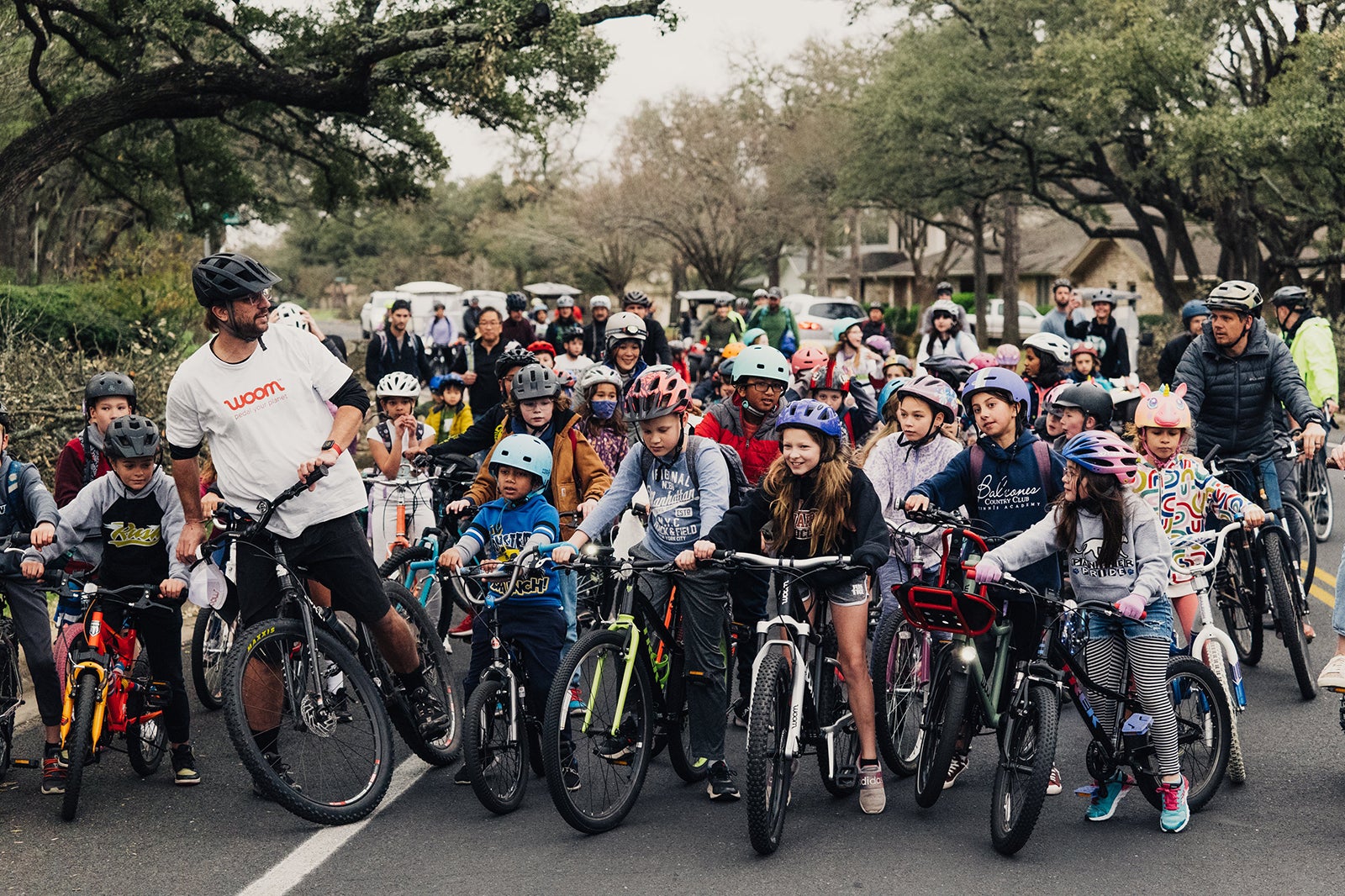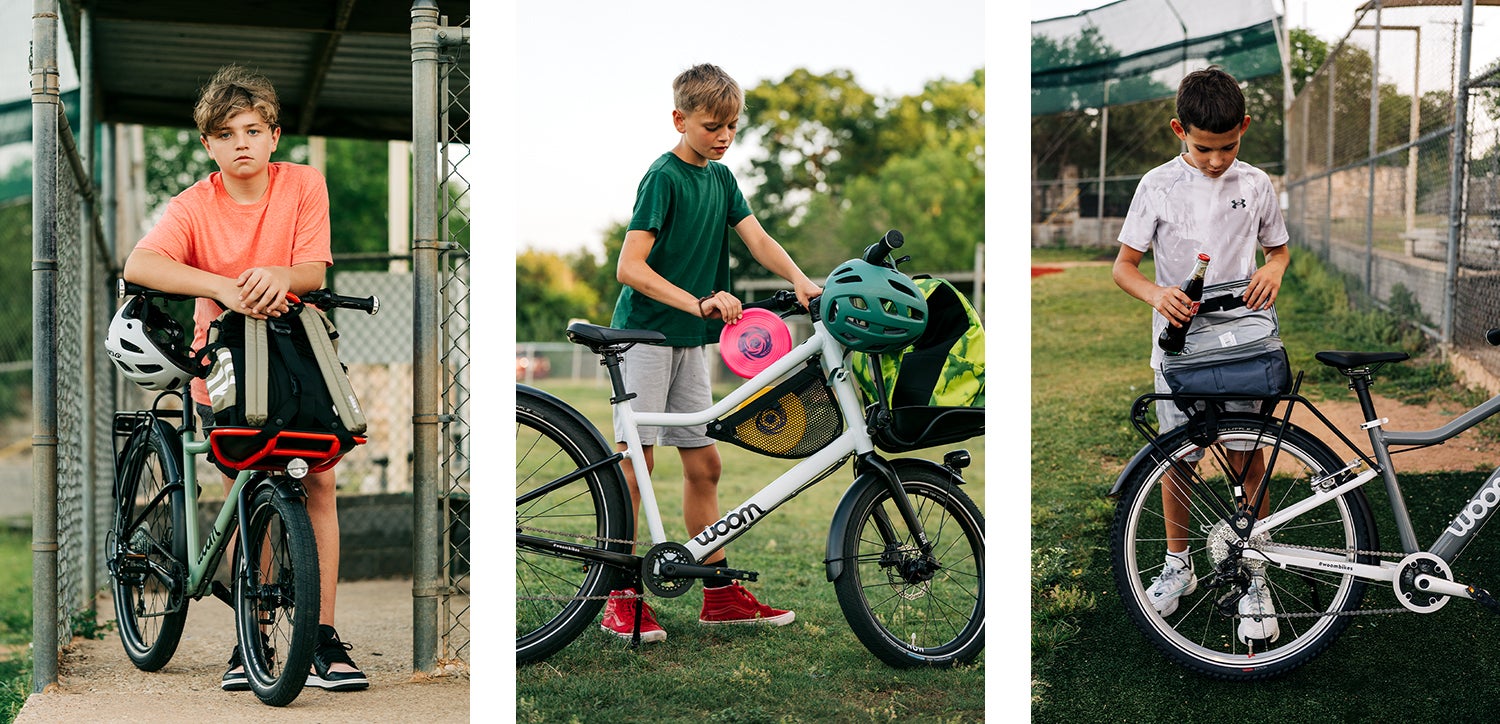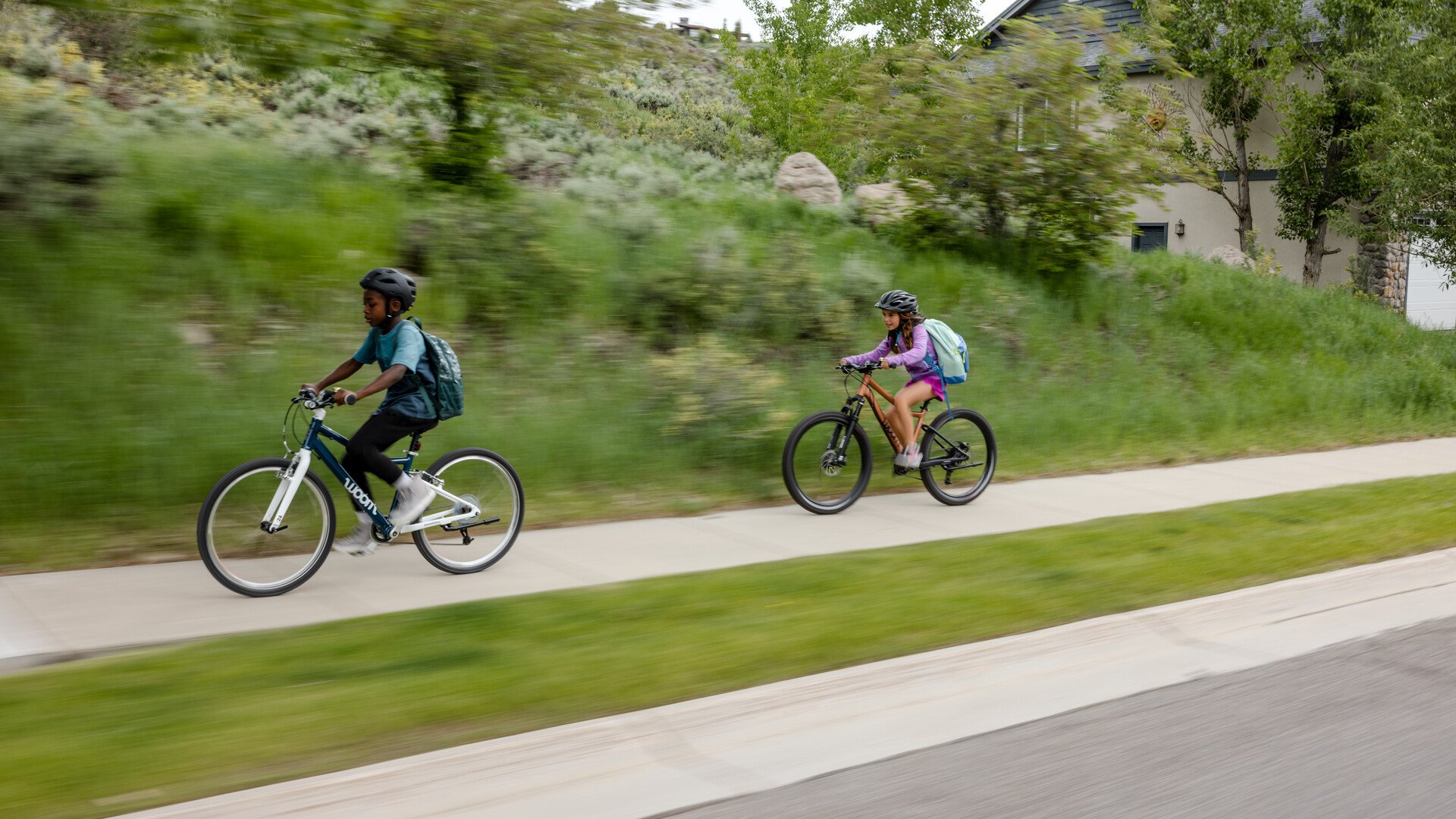How to Ride a Bike to School Safely
by Charlie LaNoue

As the back-to-school season approaches, getting ready for a new academic year often means planning new routines. As you gather up backpacks, pencils, and folders, you’ll probably also have a plan for them to get to the classroom. Some kids are driven by a car, others ride the bus or walk, and some lucky kiddos get to ride their bikes.
If your child has already learned how to ride a bike, chances are they think it’s pretty fun! Why not make the morning commute just as fun by shifting your routine to include riding bikes to school as part of the new year?
Biking to School with Kids: The Case for Active Transportation
The adage “getting there is half the fun” rarely applies to a daily commute by car — but certainly is accurate when riding to school. And it’s efficient, environmentally friendly, and adds a beneficial dose of physical activity to your day.
Here are a few reasons why biking to school is a great idea:
- You’ll save gas (and money), and get some exercise rather than adding to your car’s odometer!
- You’re establishing a healthy, active lifestyle for your child. Plus you’re getting quality time with your kiddo!
- Skip the hassle of crowded school parking lots and drop-off lines!
- Getting a boost of fresh air and vitamin D in the morning helps children arrive to class happier and more alert.
- Exercise is essential to a healthy lifestyle and will boost kids’ brain power and help them sleep better. Besides, it feels more like playtime than a chore.
- Riding a bike to school teaches your child independence, especially when they are old enough to ride with friends.
How to Get Your Child Ready to Ride a Bike to School
Cycling to school is not only a challenge for children but also for parents. Many thoughts and questions buzz through your head: What is the safest way, and where are dangers lurking? Is the bike roadworthy? How do I prepare my child to cycle to school?
To ensure your child is fully ready to roll, we have put together four tips and resources.
#1 Check the Bike
As you’re checking all those important to-dos off your list for the new school year, like buying school supplies, make sure your child’s bike is in good working order by performing routine maintenance.
- Check and tighten the quick-release skewer and the screws. The handlebar, stem, wheels, and saddle are important to check.
- Test out the front and rear brakes. Are they working correctly and delivering enough stopping power? The brake pads may need to be adjusted or replaced.
- Check the tires. Make sure there are no thorns or shards of glass hanging around. Are the tires deflated and in need of air, or are they pumped up and ready to roll? Or, maybe they’re completely flat and need a tube replaced. Are those tires looking worn down with minimal tread remaining? If so, it may be time to replace them.
- Next, dial in the fit of the bike. Double-check the seatpost height, brake lever reach, or the handlebar, and make adjustments if needed.
- To really help your child shine, give their bike a good cleaning!
- If your child’s bike is too small, it may be time to size up to the next woom bike. Here’s our helpful sizing guide to help determine the right woom bike for your child.
- Get your kids involved! This helps them get into the habit of maintaining their bike and recognizing when something isn’t working properly. Daily bike maintenance can be as easy as “ABCD” — (spoiler: it stands for Air, Brakes, Chain, Drop).
#2 Gear up for the Ride!
Having the right accessories can make or break the ride to school. From items that are worn to items that are mounted on the bike, here are a few of our top recommendations below.
- First and foremost, the most important piece of gear for riding a bike is, of course, a helmet! The woom READY Kids' Helmet has visibility-enhancing reflective accents and an easy magnetic fastener, and an optional LED rear light for extra visibility.
- A trusty water bottle is another essential. The GLUG Stainless Steel Bottle comes with a convenient side-loading bottle cage and easily mounts on the downtube of your kiddo’s bike.
- If your child is riding to school, you’ll need a bike lock that’s convenient and easy to carry, but substantial enough to intimidate a would-be thief. The LOKKI Bike Lock is a steel, 4-digit code lock that comes in bright red.
- If your child participates in after-school day events, you’ll want to be sure they’re well-lit and visible for their ride home. In addition to the reflectors on all woom bikes, we recommend investing in high-quality, easy-to-charge bike lights (not a bad idea to use even in daylight) and other reflective gear that increases visibility.
- Even when the sun is beaming brightly, you can take extra precautions, like adding a bell, to help your little Rider signal their presence and draw attention to themselves when necessary.
- Pack extra snacks for emergencies. The AMIKO Active Bag is a great solution for storing small items on or off the bike.
- Here’s another consideration: the backpack. The woom NOW bike is perfect for riding to school, as it has a built-in rack for backpacks. Another option is to add woom’s PICKUP Rack, which is compatible with most woom bikes.
- You also might want to pack a waterproof bag, rain jacket, or light sweater for those days when the weather doesn’t match the forecast.
- In search of an ideal bike for your child to ride to school (or even daycare)? The woom GO collection is perfect for younger kids ages 1.5 to 8, while the woom EXPLORE lineup offers a versatile series of bikes for growing kids ages 6 - 14. Does your child ride trails after school or take a rugged shortcut on the way? If so, check out the woom OFF and woom OFF AIR to conquer the off-road.
#3 Create a Safe Route to School
Just because your child “knows the way to school” doesn’t mean they know the best way to ride a bike to school. Sometimes, the shortest path isn’t the best.
- Often, the best route to school for children may involve a slightly more indirect route (compared to the ideal car route) that takes Riders on low-traffic residential streets rather than busy thoroughfares. However, you may be lucky enough to have a bike path or pedestrian bridge in your area that works as a “shortcut”.
- Steep hills may overwhelm your child at first. A small detour can be worthwhile if it makes the journey to school more relaxed and safer.
- We recommend checking Google Maps (use the “Biking” feature!) or consulting the global Strava heatmap to get eyes on all the best bike lanes, paths, and secret shortcuts. Look for quiet, low-traffic residential streets, cycling or multi-use paths, or good sidewalks for a wheelie fun trip to school.
- There is no substitute for scoping out the route for yourself! For example, a steep hill or a busy road may present too much of an obstacle for your little one once you have eyes on it. If possible, try to inspect the route at the time of day your child will be riding, and consider each intersection along the way.
#4 Practice Makes Perfect - Do a Trial Run First!
Once you’ve carefully crafted a bike-friendly route from home to your child’s school, take a few test rides with your kiddo! Taking a practice ride to school before the first day will help alleviate any pressure you or your child may feel about the upcoming ride and help you know how much time to allot on the first day of class. Here are some pointers and things to keep in mind for the trial run:
- Don’t push or rush your child. It is important that they ride comfortably at their own speed.
- Model safe riding practices for your child — they watch everything you do!
- Point out all the key road signs along the way to your child and ensure they understand the meaning of each.
- Point out street signs and refer to streets by name so your child can learn.
- Teach them about potential challenges they may face while cycling, such as curbs, hidden driveways, or traffic hazards. Together, practice crossing busy intersections.
- Practice the route in both directions; the return ride home will likely have a few differences.
- If your child is old enough to ride alone to school, be sure they have the route memorized. To make sure they know the route by heart, have them guide you before you send them on their own.
Pro Tips for Commuting by Bike With Kids
With your child’s bike in good working order, their bike gear in place, and a well-practiced route drawn up, you’re finally ready to let your kiddo ride a bike to school! To ensure your child gets to school safely by bike, explore these tips for an unforgettable biking experience.
#1 Follow these Bicycle Safety Tips for School Commuting
Here are a few general best practices to teach your child when you ride with them to school.
- Keep your Rider close — riding right in front of, behind, or beside you (when possible on a bike path or a low-traffic side street, for example).
- Make sure your child listens to and follows verbal commands, and is capable of staying alert to potential dangers on your route.
- Teach your child that if they’re in doubt about how to handle a situation, they should stop and walk their bike, which gives them much greater control.
- Pay especially close attention to drivers making right and left turns, and make eye contact with the drivers when possible before crossing.
- Teach your child to always use a clear hand signal when turning left or right.
- Check over your shoulder before turning, and explain the importance of doing so to your child.
#2 Avoid Potential Dangers
Your child needs to learn how to spot hazards and know what to do when they come across them.
- Stay about three feet away from the curb to ensure their pedals don’t strike the edge.
- Maintain a safe distance from car doors — keeping about three or four feet away from parked cars will avoid the risk of you or your child being hit by a car door suddenly opening.
- Make sure it’s safe before crossing intersections, and don’t forget to account for any cars that might be turning. Making eye contact with all drivers is best.
- Slow down and be cautious around driveways and parking lot entrances, as drivers have poor visibility in these areas.
- Don't forget that larger vehicles, like buses and semi-trucks, have a bigger blind spot than smaller vehicles, and stay out of their way when possible. Avoid stopping alongside or directly in front of a vehicle because the driver might not have a clear view of those areas. If you can't look into the driver's eyes, they can’t see you either. It is safest for you to stop behind a vehicle, leaving a big enough gap between it and your bike.
- Train tracks can pose a risk if not treated properly, especially when they intersect with a road diagonally. To avoid one’s bicycle tires sinking into a rut, always cross train tracks with care and at a 90-degree angle because if not, a bike tire could easily get caught and cause you to fall.
#3 Pedal, Laugh, Play, Repeat
There’s no shortage of ways to inject fun into biking to school. From encouraging neighborhood friends and families to join to rewarding your little Rider with a tasty treat or visiting a park on the way home, associating the ride with fun will create a positive feedback loop for your child.
Play games as you go — bike bells can add an element of fun, and with a little imagination, your woom bike can become a spaceship, motorcycle, or flying T-Rex.
#4 Ride in Groups. There’s Power in Numbers!
Few things are more fun than kids riding bikes with other kids. When kids ride in groups they are much safer and less likely to go unnoticed by an errant motorist.
- Create a “bike bus” or “bike train” by coordinating with other parents who live near or along your route. Plan out stopping points and times, and work your way on to the next stop. Bonus: you’ll get to meet and socialize with other bike-minded parents!
- For older kids, you may encourage them to ride to school with their friends. They can build connections and enjoy a sense of camaraderie without their fingers glued to their smartphones. Less screen time and more wheel time? Yes, please!
- Have a younger child? Commuting by bike with a big brother or sister is still an option! Try running with a jogging stroller or riding with a bike trailer, child seat, or other add-ons for your little one.
- Ask your local school staff about creating and maintaining safe conditions around the school zone.
- The more, the merrier! More children arriving at school on foot or bike means fewer cars vying for limited space, more visibility for pedestrians and cyclists, and a safer buffer zone around the school.
#5 Wear the Right Clothes
An old Scandinavian saying goes, “There is no such thing as bad weather, only bad clothes.” You can cycle year-round in almost any condition. If you’re seeking inspiration, pull up city scenes from Copenhagen — in this Viking land of very frequent cold and rain, 41% of Copenhageners’ trips to work or school are made by bike, and many people don’t even own a car (there are 5.6 bikes for every car in the city, translating to roughly 675,000 bikes and 120,000 cars).
The key to commuting in less-than-ideal conditions is having the gear that will keep you comfortable.
- Fall/Spring: In shoulder seasons, carry additional thin layers of clothing in a backpack or panniers.
- Winter: In some places, winter means snow drifts. In others, it may mean wearing a thicker pair of socks with your cargo shorts. What’s key anywhere are close-fitting layers that can be added or removed as needed, and an outer layer that serves as a windbreak. You’ll also want to give some thought to the extremities, adding to your riding wardrobe a thin hat, ear covers, or balaclava; gloves (woom offers full-fingered gloves that are well-suited for milder temps); and wool socks.
- Summer: Again, climates vary widely. If you live in a particularly hot climate, a few tips: seek out routes with shade, avoid commuting in the hottest times of day if possible, bring ice water, apply sunscreen, and get a well-ventilated helmet (the woom READY Kids' Helmet has 12 ventilation holes and internal air channels).
- Rainy: Light rain is no reason to hang the bike up in the garage! A waterproof jacket and waterproof pants over regular clothing often do the trick.
#6 Carry Cargo Correctly and Comfortably
If your child regularly bikes to school, it is worth investing in a bicycle basket or a rear rack with straps to attach it. With a woom NOW, backpacks and other gear can be transported safely and easily on its innovative front rack. Although carrying cargo using a front rack, basket, or panniers is preferred, many children carry their school bags on their backs. So here are a few best practices for biking while wearing a backpack and other tips for carrying cargo in general:
- Practice: Before the first ride, your child should practice turning and braking with their fully loaded backpack. Make sure your child can steer safely and keep their balance.
- Shoulder straps: Your child should always wear their backpack on both shoulders and tighten the shoulder straps to prevent the bag from dangling and affecting balance. Ideally, the backpack should have chest and lap straps that provide extra support.
- Weight distribution: How the backpack is packed is also important. Position heavy materials, such as books, as close to the back panel as possible.
- Weight: Ask yourself if all items are essential. Possibly certain things, like laptops or heavy books, can be left at school.
- Attach: Make sure that any accessories are correctly and securely attached to the bike and that no straps can get caught in the spokes.
#7 What NOT to do
We want your child to enjoy cycling to school, but there are certain things they just flat out shouldn't do. Here are the no-gos for cycling to school and generally on the road:
- Play loud music: Biking while listening to headphones isn't wise since it will limit your child’s perception and attention. Save the music for after the ride!
- Use a cell phone: Same as when driving a car, distracted cycling is a big no-no. Teach your child to pull over and stop in a safe location if they need to check their phone for any reason.
- Leave a bike unlocked: An unlocked bike at school is an invitation for bike thieves. That's why your child should always protect their bike with a high-quality bicycle lock, even if it’s just a short stop.
- Act recklessly: Horseplay can be fun, but has no place when riding a bike. Tailgating, pranking, or narrowly passing others should all be avoided.
- Ride side by side: Children have a lot to tell each other — so it makes sense for two to ride side by side on the way to school or home to talk better. But be careful: while this may be safe on quiet side streets or a bike path, this is dangerous on a moderately busy road and a narrow bike lane.
#8 Consider Traffic From a Child's Point of View
To ride a bike on the road safely, there are quite a few skills your child will be developing along the way. It’s important to acknowledge that your child views the world around them very differently than you. Consider the following:
- Height: Because they’re shorter, children will have a less clear view of the road ahead than you. With this in mind, assess the route from your child’s perspective and identify any risks they may face.
- Visual cues: Children are still developing their ability to judge distance and speed until age nine. So, in your child’s view, a big car may appear nearer than a small car. And up until age 12, their peripheral vision is still limited. This means they won’t be able to notice a vehicle approaching from their side as well as an adult.
- Attention and concentration: Young children are particularly distractible; for example, a dog walking past may cause them to lose focus. By the time they are eight years old, your child will be able to concentrate on one thing for longer, allowing them to focus more easily on biking to school with you.
- Logical thinking: Until they reach about seven years old, your child has an egocentric view of the world. This means that if they see a car, they assume that the driver also must be able to see them.
- Reaction time: A five-year-old's reaction time is about double that of an adult's. Not until they hit puberty will their reaction time start to catch up with yours.
- Risk assessment: Your child won't be in a position to make rational decisions just yet. For example, they'd pick the shorter route over the safer one. By about age five, they'll start to develop a general sense of danger. Still, even then, it may take them a while to be able to dodge risky situations and react to them appropriately.
Helping your kid ride a bike to school can feel challenging at first in a society where cars are the dominant mode of transportation. Many American children live too far away from the school they attend to reasonably commute by bike. That said, there are still millions of American children who live fewer than two miles from their school who could start to ride their bikes to school, save their parents a bit of gas, and get some exercise along the way.
While events like National Bike-to-School Day are fantastic, at woom bikes, we are committed to seeing more children ride their bikes to school daily. Reach out to us, and we’d love to chat about your child’s current bike fit, future bike considerations, bike gear, or any other woom-related business. And don’t forget to share your bike-to-school photos with us by tagging @woombikesusa or #woombikesusa on Instagram! We wish you and your children a fantastic school year!

